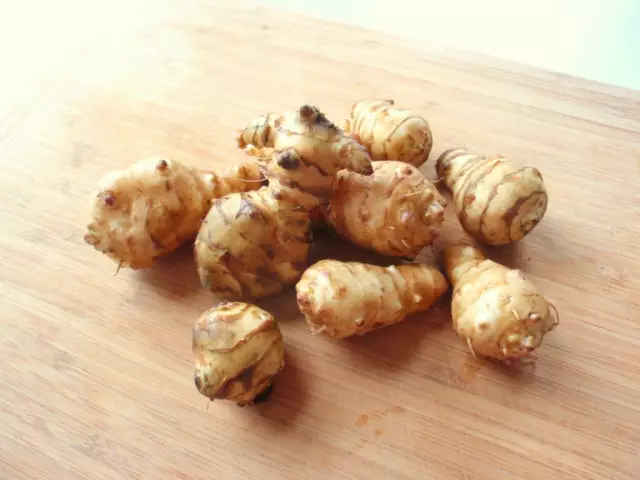- Author Rachel Wainwright [email protected].
- Public 2023-12-15 07:39.
- Last modified 2025-11-02 20:14.
Perilla
Perilla is a perennial plant from the Lamb family. The plant reaches a height of 40-60 centimeters. The plant can be divided into three types according to the color of the stems: with red, pink-purple and green leaves. Perilla contains many useful substances and essential oils. So, for example, in terms of carotene content, a plant can easily compete with carrots.

There are two types of railings:
- Basil, which is mainly grown for seeds for the production of essential oil;
- Nanjing, or salad, which is used in cooking as a spice.
Perilla has a beautiful appearance, especially its red-leaved species, which are often used to decorate dishes.
The plant has a strongly branched structure, the leaves are large, dryish and wrinkled to the touch. In Japan, perilla is an indispensable attribute of garden decoration.
In Russia, varieties of Japanese selection are mainly used. The varieties Akashiso and Aoshioso give good yields. Of the varieties of Russian selection, the Rosinka variety is popular, since it is cold-resistant, early ripening and has a long growing season - 150 days. Currently, domestic breeders are busy breeding new varieties of plants.
Perilla loves loose, well-fertilized soils. The plant is grown mainly by seedlings, using the potting method. The seeds of the plant germinate very slowly, therefore, before sowing, they are soaked for several days, and the water is changed at least three times a day.
For seedlings, seeds are sown in April-May, and with the appearance of two true leaves, the seedlings dive into greenhouses or film greenhouses at a distance of 20-30 centimeters from each other.
They start harvesting greenery at the beginning of flowering. Shoots are cut at a height of 10 centimeters from the ground. As a rule, two cuts are made per season. Depending on the growing conditions, the average yield is 0.5-5 kg per square meter.
Fresh greens are stored for up to seven days if you put them in the refrigerator in a glass jar and cover with a lid. It is not recommended to store the perilla in plastic bags, as it quickly decays. For long-term storage, traditional greens are used.
The use of perilla in cooking
Perilla greens have a mild aniseed and lemon aroma, the taste is juicy and delicate, with a slight peppery flavor. Leaves of young plants are used mainly fresh. Also, the leaves are pickled, salted and added to the preparation of various drinks and sauces.
Powder is made from dry perilla leaves, which is used as a spice, adding to vegetable and meat dishes. Basically, green-leaved plant varieties are used as a spice.
Red-leaved varieties are added to all kinds of pickles to give them color. In Japan, for example, red-leaved perilla is added when stachis is salted. At the same time, stachis tubers acquire a delicate specific aroma and a beautiful pink-red hue.

The healing properties of perilla
Perilla essential and fatty oils, which are found in large quantities in the seeds and leaves of the plant, have the main healing effect. Various infusions and decoctions are made from seeds and leaves, which have an antiseptic, sedative and analgesic effect. They are used for coughs, colds, bronchitis, and are also used as a diaphoretic and diuretic.
Perilla oil has great medicinal properties. It is obtained from plant seeds by cold pressing.
Perilla oil contains a large amount of alpha-linoleic acid - about 64%. This acid is the most important unsaturated acid necessary for the full functioning of the human body. Oleic and linoleic acids are present in perilla oil in the amount of 15% and 17%, respectively. It should also be noted that perilla oil is the only vegetable oil that contains twice as much omega-3 acids as fish oil.
The use of oil helps with various skin diseases, lowers blood cholesterol levels and blood pressure, positively affects the state of the nervous system, and reduces inflammation of the joints.
Perilla oil contains tannins and phenolic compounds (luteolin, catechin, rosmarinic acid, apigenin), as well as glycosides, flavonoids, terpenes, which have powerful anti-inflammatory, antibacterial, antiviral and antioxidant properties.
Rosemary acid protects the skin from the harmful effects of ultraviolet radiation, stabilizes cell membranes, fights free radicals, which is also associated with the anti-cancer properties of perilla oil.
In addition, perilla oil is widely used in Southeast and Japanese cosmetology and perfumery. It moisturizes and nourishes the skin well, relieves itching and irritation. Various creams, scrubs and face masks, as well as hair conditioners and shampoos are prepared on the basis of the oil.
YouTube video related to the article:
Found a mistake in the text? Select it and press Ctrl + Enter.






